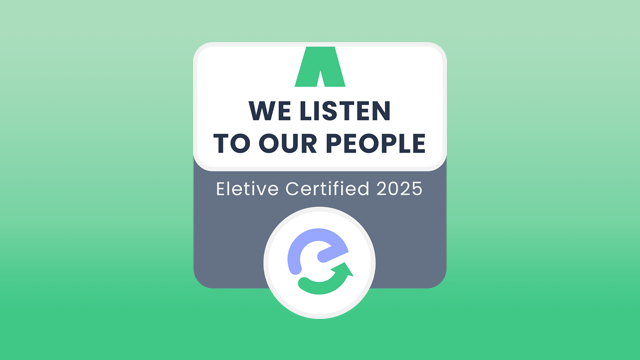Some organisations struggle to motivate employees to take part in surveys, leading to low participation rates. Luckily, there are ways to improve the response rates and increase engagement.
In this article, we take a closer look at best practices that can help you increase participation in employee engagement surveys.
You can also watch our webinar with our employee engagement experts Emelie Nilsson, Team Lead Customer Success, and Shino Diabate, Enterprise Account Executive. They share their experience related to customers and how they managed to increase their participation rates in employee surveys.
3 strategic steps for increasing participation
When increasing the employee survey participation rate, it can help to break down the process into three strategic steps that involve different actions. These are preparation, implementation, and follow-up. Below and in the webinar we go through each step in detail.
1. Preparation of employee surveys and participation
Communicate the purpose and benefits
Set clear expectations
Make sure to have surveys in multiple languages and multiple accessibility points ( eg Voice-over)
Guarantee the anonymity of participants
Train your managers and get buy-in from top management
2. Implementation of employee surveys and participation
Integrate with your HR-tool
Tailor the tool to your organization
Adapt depending on white/blue-collar
Make it easy and convenient
Send out creative reminders
3. Follow-up of employee surveys and participation
Be transparent
Encourage open and honest feedback
Highlight your strengths Identify areas for improvement
Follow up regularly to keep people aligned and celebrate the positive outcomes
Communicate the changes you've made
Intelligent pulse surveys increase participation rates
What is the reason for decreasing participation rates? Well, with yearly surveys, sometimes the sheer size and scope of the surveys can mean that people don't complete the survey. It's simply too time-consuming. And with overly repetitive pulse surveys, there is the dreaded "survey fatigue" that often sets in after a few rounds.
At Eletive, we recognise these challenges and have built a more modern solution to maximise employee engagement survey participation. Eletive surveys are driven by advanced survey intelligence, powered by machine learning and adaptive algorithms. This means that employees don't receive the same survey questions every time.
Instead, they receive the most relevant ones, based on their answers in the previous survey. This approach comes with numerous benefits, and one of them is that it creates a better employee experience and prevents survey fatigue.
Related reading: How intelligent pulse surveys can improve your people's decisions
Send regular pulse surveys rather than one yearly survey
By sending out regular surveys, you give your employees more than one chance per year to participate. Exactly how often you should send surveys depends on several factors, and with Eletive, you can choose the frequency that works for your organisation. You can also let different parts of the organisation get the surveys at different frequencies.
Contrary to what many believe, sending out surveys often and regularly does not decrease participation. Instead, it often increases it! One reason for this is that if you send out the survey, for example, bi-weekly, it will contain fewer questions.
If you use the standard Eletive question battery, sending the employee survey bi-weekly means it contains only four questions each time. With regular pulse surveys, it only takes a minute to answer. And when people realise this, most companies start seeing a really good response rate.
Related reading: Real-time pulse surveys vs. annual employee engagement surveys
Add open-ended questions to your employee surveys
Adding open-ended questions to your surveys allows respondents to share their feedback in a more open format. This means it's possible to address issues that are not covered by the questionnaire. Open-ended questions not only increase participation but also improves the quality of the survey results.
If your organisation is large, managing all the data from open-ended questions may seem challenging. But with Eletive, AI will help you process the answers automatically. This is a great way to find out about issues that may otherwise have gone unnoticed for a longer period, leading to more significant problems. Finding out early is the key to a proactive approach, and open-ended questions are an excellent tool for this.
Related reading: The best employee engagement survey questions – what to ask and why
Take action on the survey results
It's important to remember that gathering employee feedback is not an end in itself. What's important is to also turn the insights from the employee survey responses into tangible action.
When employees notice that they can help drive positive change by participating in employee surveys, this improves the survey response rate. And, of course, the opposite is equally true when there is no action. If employees notice that nothing ever happens as a result of the feedback they give, they will eventually be less prone to participate in surveys.
The best way to take action is often to include employees in the action planning. This creates a sense of ownership and accountability and sends the message that everyone is responsible for the outcome together.
The Eletive platform makes it easy to connect the survey results to actions and turn them into a to-do list. This also means it's easy to track if the actions being taken are affecting the survey results so that managers and teams can iterate and be agile.
Related reading: Learn more about action plans in the Eletive platform
Integrate your employee survey tool with calendars and communication apps
One very simple way to increase employee survey participation is to make it as convenient and straightforward as possible for employees to respond to the survey. By integrating your survey tool with the calendars and communication apps you use, your employees will get reminded to answer the survey inside the apps where they spend most of their time.
So, for example, they'll get a reminder on slack with a link to the survey, and then all it takes is a click to open it and a few more clicks to answer it. No interruption, and no need to log in or out of systems, which makes a big difference.
Related reading: Integrating Eletive with your current tech stack
Best practice to improve employee survey participation
Have a plan for preparing the organisation
Have an implementation plan
Have surveys in multiple languages
Make sure to use adaptive devices
Send regular pulse surveys rather than one yearly survey
Add open-ended questions to your employee surveys
Integrate your employee surveys with calendars and communication apps
Secure anonymity
Follow up and involve the organisation
Take action on the survey results
Ready to improve participation in your employee surveys?
Get the tools you need to measure and increase engagement and performance and build a culture of self-leadership with high participation in the surveys.

























:format(jpeg)/f/288714721386412/fa3fda4021/kopia_av_blog_graphics__presentation__169____1280____720_px___kopia_.jpg)
:format(png)/f/288714721386412/70a5012076/blog-eletive-secures-growth-investment-from-accel-kkr-hero_media.png)
:format(jpeg)/f/288714721386412/a906f14dff/blog-hr-trends-2026-ai-data-and-employee-experience-hero_media.jpg)
:format(png)/f/288714721386412/9f8e0a2347/blog-beyond-the-hype-the-new-rules-of-people-success-in-a-global-ai-powered-hero_media.png)